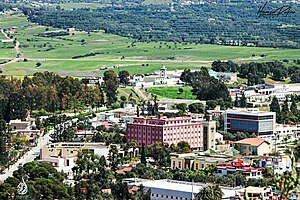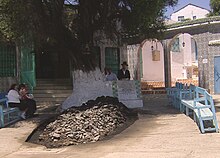Ouezzane
| Ouezzane وزان ⵯⴰⵣⴰⵏ |
||||
|---|---|---|---|---|
|
||||
| Basic data | ||||
| State : |
|
|||
| Region : | Tangier-Tétouan-Al Hoceïma | |||
| Province : | Ouezzane | |||
| Coordinates | 34 ° 48 ′ N , 5 ° 34 ′ W | |||
| Residents : | 59,606 (2014) | |||
| Area : | 10.3 km² | |||
| Population density : | 5,787 inhabitants per km² | |||
| Height : | 220 m | |||
| Ouezzane | ||||
Ouezzane or Ouazzane ( Arabic وزان, DMG Wazzān , Tamazight : ⵯⴰⵣⴰⵏ) is a provincial capital with around 60,000 inhabitants in the Tanger-Tétouan-Al Hoceïma region in northern Morocco . The city is considered to be one of the most important religious centers in Morocco and a “holy” city because of its Sherif and a resident Sufi brotherhood.
Location and climate
Ouezzane is located in the southwestern foothills of the Rif Mountains in the transition to the Rharb or Gharb plain at an altitude of about 300 to 400 m ; the Jbel Bou Hellal (610 m) dominates the place. The distances to Chefchaouen and Tétouan are approx. 70 km (driving distance) and 125 km in a north-easterly direction; Ksar-el-Kebir and the coastal town of Larache are about 55 km and 85 km to the northwest, respectively. The climate is quite rainy by Moroccan standards; the average annual rainfall is around 845 mm and it falls mainly in the winter half-year.
population
| year | 1994 | 2004 | 2014 |
| Residents | 52,168 | 57,972 | 59,606 |
The inhabitants of Ouezzane are almost exclusively of Berber descent ( Rifkabylen ); both Tarifit and Moroccan Arabic are spoken . Most of the Jews who used to live here emigrated after the establishment of the State of Israel (1947) and especially after the independence of Morocco (1956).
economy
In the past, the inhabitants of the village, which had only about 3000 inhabitants at the beginning of the French Protectorate (1912), lived as semi-nomads and as self-sufficient people from cattle breeding (sheep, goats, chickens), a little agriculture (barley, vegetables) and tree fruits (olives, apples, Pears, cherries etc.); Weaving, craft and retail trade still play a certain role. Today the city is a regional service center with administrative authorities, banks, training centers, health centers, etc.
Legends and history
According to legend, the city and the lines of the descendants of the Prophet Mohammed there were founded in the 9th century by one of Idris II's sons , who had settled in Ouezzane. Officially, however, the establishment goes back to the Alawid Abdallah Ben Ismaïl in 1727. For many of his descendants today - in contrast to most Arabs and Berbers - green eyes are typical. The accumulation of these genetic traits in northern Morocco cannot be explained by more frequent intermingling with Spaniards and French, because the Beni Sliman tribe, most of whom live in the Casablanca area, are mostly green-eyed and in Ouezzane this phenomenon occurred before the colonial era. In contrast to the rest of Morocco, Ouezzane was not occupied by colonial troops until 1920. In 1925 an attempt by the insurgent Rif-Kabyle to capture Ouezzane failed. In 1937, however, there was a brief uprising against the colonial power, in which the patriotic politician Muhammad Hassan al-Wazzani from Ouezzane was also involved.
The most important Sherif families in Ouezzane are the Dar and Admana. Today's Moroccan royal family also calls itself the Alawiden (Aliden), d. H. Descendants of Mohammed, Ali , Fatima and Hassan . At least in parts of the "real" Ouezzane Sheriffs, however, this agreement is openly questioned. The Alavids did not immigrate until the 13th century, when the Merinids, descended from the Idrisids, came to power in Morocco and the Sherif began to promote.
It is noteworthy that King Mohammed V died shortly after a visit to Ouezzane in 1961. It was then that there was a rumor of poisoning. What is certain is that his successor Hassan II never visited Ouezzane. Hassan's successor, the current King Mohammed VI. , undertook an extensive journey through all the cities of the country after taking office, but had excluded Ouezzane of all people and avoided it to this day.
Attractions
- The medina of Ouezzane, with its winding and partly built-up alleys, is far more ancient, but ultimately not as attractive as that of Chefchaouen .
- For Moroccans, the most important building is the pilgrim mosque of the Tabiya Brotherhood ( Zaouia ) with its octagonal minaret.
- The exterior of the Moulay Abdallah mosque, which was built on the orders of Hassan II instead of a previous building and consecrated in 1968, is also well worth seeing.
Others
Ouezzane is a holy place for Moroccan Jews too . Approx. 10 km northwest of the city, in the Rif Mountains , lies the mountain village of Asjen with the burial place of the rabbi Amran Ben Divan, also called "Moul Anrhaz", who died here in 1782 on a trip from his home in Hebron in the Holy Land . Typical of the religious culture of the regions in Morocco inhabited by Berbers is the fact that both Muslims and Jews venerate this man as a saint to this day (see also Sefrou ). The pilgrimage in honor of this marabout is called moussem by the Muslims and hiloula by the Jews .
literature
- Ingeborg Lehmann, Rita Henns: Morocco. Baedeker, Ostfildern 2010, p. 360ff, ISBN 978-3-8297-1251-4 .
Web links
- Ouezzane, history and monuments - Photos and information (English)
- Ouezzane - video
- Ouezzane - photo video



